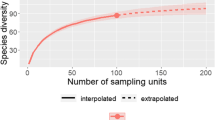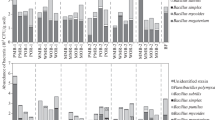Abstract
The microbial complexes of soil, the rhizosphere, and the rhizoplane of the apogeotropic (coralloid) roots of cycad plants were comparatively studied. The aseptically prepared homogenates of the surface-sterilized coralloid roots did not contain bacterial microsymbiont, indicating that in the root tissues the symbiosis is a two-component one (plant–cyanobacteria). At the same time, associated bacteria belonging to different taxonomic groups were detected in increasing amounts in the cycad rhizoplane, rhizosphere, and the surrounding soil. The bacterial communities found in the cycad rhizoplane and the surrounding soil were dominated by bacteria from the genus Bacillus. The saprotrophic bacteria and fungi colonizing the cycad rhizosphere and rhizoplane were dominated by microorganisms capable of degrading the plant cell walls. The local degradation of the cell wall was actually observed on the micrographs of the thin sections of cycad roots in the form of channels through which symbiotic cyanobacterial filaments can penetrate into the cortical parenchyma.
Similar content being viewed by others
REFERENCES
Grushvitskii, I.V. and Chavchavadze, E.S., The Class Cycadopsida, in Zhizn' rastenii (The Life of Plants), Moscow: Prosveshchenie, 1978, vol. 4, pp. 268-295.
Milindasuta, B., Developmental Anatomy of Coralloid Roots in Cycad, Am. J. Bot., 1975, vol. 62, pp. 468-472.
Ahern, C.P. and Staff, I.A., Symbiosis in Cycads: The Origin and Development of Coralloid Roots in Macrozamia communis (Cycadaceae), Am. J. Bot., 1994, vol. 81, pp. 1559-1570.
Rai, A.N., Söderbäck, E., and Bergman, B., Cyanobacterium-Plant Symbiosis, New Phytol., 2000, vol. 147, pp. 449-481.
Meeks, J.C., Symbiosis between Nitrogen-fixing Cyanobacteria and Plant, BioScience, 1998, vol. 48, pp. 266-276.
Filippi, C., Bagnoli, G., and Giovannetti, M., Bacteria Associated to Arbutoid Mycorrhizas in Arbutus unedo L., Symbiosis, 1995, vol. 18, pp. 57-69.
Garbae, J. and Bowen, C.D., Stimulation of Ectomycorrhizal Infection of Pinus radiata by Some Microorganisms Associated with the Mantle of Ectomycorrhizas, New Phytol., 1989, vol. 112, pp. 383-388.
Garbae, J. and Duponnoids, R., Specificity and Function of Mycorrhization Helper Bacteria (MHB) Associated with the Pseudotsuga menziesii-Laccaria laccata, Abstr. of International Symbiosis Congress, Jerusalem, 1990, p. 50.
Grilli Caiola, M., A Light and Electron Microscope Study of Blue-Green Algae Growing in the Coralloid Roots of Dioon edule and in Culture, Phycologia, 1975, vol. 14, pp. 25-32.
Grobbellaar, N., Scott, W.E., Hattingh, W., and Marshall, J., The Identification of the Coralloid Root Endophytes of the Southern African Cycads and Ability of the Isolates to Fix Dinitrogen, S. Afr. J. Bot., 1987, vol. 85, pp. 111-118.
Dobrovol'skaya, T.G., Skvortsova, I.N., and Lysak, L.V., Metody vydeleniya i identifikatsii pochvennykh bakterii (Methods for the Isolation and Identification of Soil Bacteria), Moscow: Mosk. Gos. Univ., 1989.
Bergey's Manual of Determinative Bacteriology, 9th ed., Holt, J.G. et al., Eds., Baltimore: Williams & Wilkins, 1994. Translated under the title Opredelitel' bakterii Berdzhi, Moscow: Mir, 1997.
Gauze, G.F., Preobrazhenskaya, T.P., Sveshnikova, M.A., et al., Opredelitel' aktinomitsetov (Manual of Actinomycetes), Moscow: Nauka, 1983.
Domsch, K.N., Gams, W., and Anderson, T.H., Compendium of Soil Fungi, Eching: IHW, 1993, vol. 1.
Baulina, O.I., Lobakova, E.S., Korzhenevskaya, T.G., Butenko, R.G., and Gusev, M.V., The Ultrastructure of Ginseng Cells and the Cyanobacterium Chlorogloeopsis fritschii Grown in Association in the Dark, Vestn. Mosk. Univ., Ser. Biol., 1995, vol. 50, pp. 1-16.
Lobakova, E.S., Zagoskina, N.V., Troshina, U.V., Korzhenevskaya, T.G., and Gusev, M.V., Structure of Coralloid Roots and the Synthesis of Phenol Compounds Therein: A Study with Different Cycad Species, Progr. Abstr. and Papers of the Third Int. Congr. on Symbiosis, Marburg, 2000, p. 57.
Lobakova, E.S., Dubravina, G.A., Zagoskina, N.V., and Korzhenevskaya, T.G., Soluble Phenol Compounds of Cycad Apogeotropic Roots, Int. Symp. “Plant under Environmental Stress,” Moscow, October 23–28, 2001, pp. 168-169.
Zaprometov, M.N., Fenol'nye soedineniya: rasprostranenie, metabolism i funktsii v rasteniyakh (Phenolic Compounds: Distribution, Metabolism, and Role in Plants), Moscow: Nauka, 1993.
Zvyagintsev, D.G., Dobrovol'skaya, T.G., Bab'eva, I.P., Zenova, G.M., Lysak, L.V., Polyanskaya, L.M., Chernov, I.Yu., The Structural and Functional Organization of Microbial Communities, in Ekologiya v Rossii na rubezhe XXI veka: nazemnye ekosistemy (Ecology in Russia at the Threshold of the 21th Century: Terrestrial Ecosystems), Moscow: Nauchnyi Mir, 1999, pp. 147-180.
Costa, J.-L., Paulsrud, P., and Lindblad, P., Cyanobiont Diversity within Coralloid Roots of Selected Cycad Species, FEMS Microbiol. Ecol., 1999, vol. 28, pp. 85-91.
Author information
Authors and Affiliations
Rights and permissions
About this article
Cite this article
Lobakova, E.S., Orazova, M.K. & Dobrovol'skaya, T.G. Microbial Complexes Occurring on the Apogeotropic Roots and in the Rhizosphere of Cycad Plants. Microbiology 72, 628–633 (2003). https://doi.org/10.1023/A:1026015921930
Issue Date:
DOI: https://doi.org/10.1023/A:1026015921930




